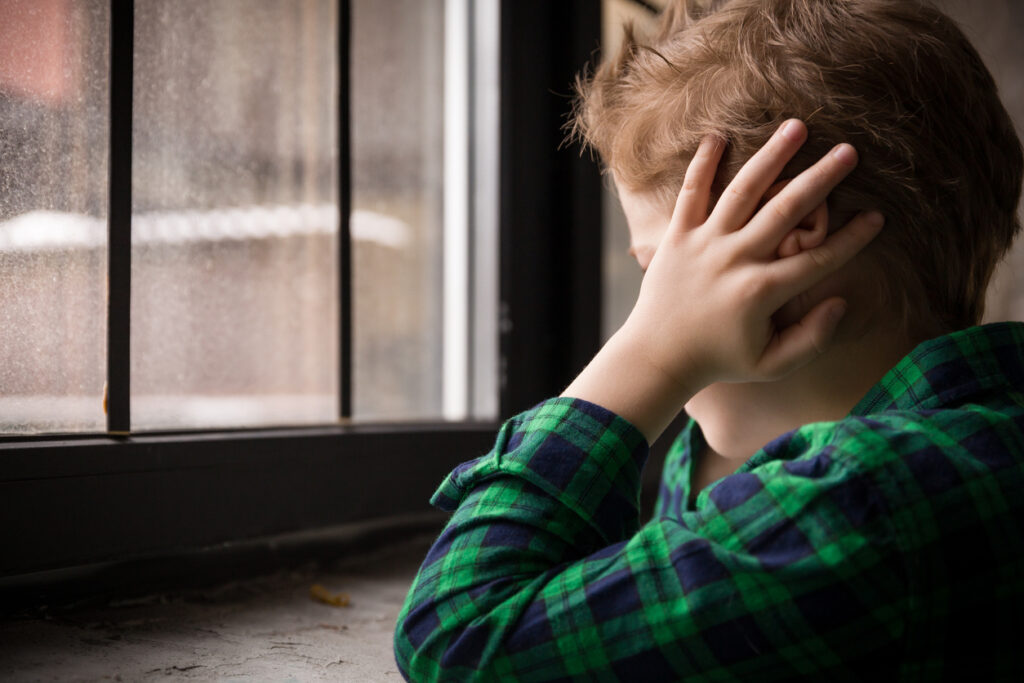
Our first post for Adoption Awareness Month discussed the seven major issues common to all adopted children. Let’s recap those before diving into the specific effects early trauma has on the physiological, social, and emotional development of children. The seven core issues of adoption are: loss, rejection, guilt/shame, grief, identity, intimacy, and control/mastery. While every adoption story is different, one thing to remember is that there is no adoption without loss. Experts consider separation from birth parents – even as an infant – as a traumatic event. Therefore, every adopted child experiences early trauma in at least one form. Many experience additional trauma before adoption. This compounds the potential negative effects on their physiological, social, and emotional development across all stages of life.
Before going further, we should address the basics of what we know about the long-term effects of early trauma on physical and behavioral health. Mental health professionals refer to the various types of early trauma as Adverse Childhood Experiences (ACEs). In 1998, the Centers for Disease Control (CDC) and Kaiser Permanente published The Ace Study. This seminal work changed our understanding of early trauma.
Click here to read our post on The Ace Study
For now, understand that behavioral health professionals identify the ACE Study as the beginning of an approach to mental and emotional healthcare practices now commonly called trauma-informed care. Since then, researchers have conducted scores of studies and reached conclusions that are important to our understanding of early trauma.
A heads up: early trauma has lasting impacts and far more negative health effects than most people realize.
Adverse Childhood Experiences: Long-Term Effects
According to the Substance Abuse and Mental Health Services Administration (SAMHSA), ACEs increase the likelihood of the following issues:
- Early alcohol use
- Illicit drug use
- Prescription drug misuse
- Alcohol use disorders
- Substance use disorders
- Suicide attempts
- Depression
- Risky sexual behavior
- Adolescent pregnancy
- Lowered IQ
- Impaired cognitive function
- Diabetes
- Heart Attack
Just to make sure we’re on the same page, here’s a list of childhood experiences considered adverse:
- Physical, emotional, or sexual abuse
- Physical or emotional neglect
- Domestic violence
- Living with an individual struggling with substance abuse, an individual diagnosed as mentally ill, or an individual who was incarcerated or sentenced to be incarcerated
- Experiencing racism and/or bullying
- Living in foster homes
- Living in an unsafe neighborhood
- Witnessing violence
Once you read this list, it’s easy to understand the reason adopted kids are almost universally at-risk of long-term physical and behavioral health problems. Why? Because in the majority of cases, adopted kids meet many of the criteria listed above. First, they’re separated from their birth parents – that’s a fundamental truth. Second, they’re often removed from their birth parents because the environment is unsafe. Think domestic violence, physical or emotional neglect, a parent being incarcerated, or physical/sexual/emotional abuse. Third, many end up living in foster homes while awaiting adoption. This is another form of trauma in addition to the trauma they’ve experienced already.
Now, let’s drill down on what happens in the brain when kids experience trauma.
Childhood Trauma: Effect on Brain Development
Research shows that toxic stress has significant negative impacts on the development of key structures in childhood brain development. The areas of the brain affected are:
Hippocampus
The hippocampus is crucial to learning and memory. Early stress can reduce hippocampus size, as well as it’s ability to regulate levels of the stress hormone cortisol after a traumatic event.
Corpus Callosum
The largest white matter structure in the brain, the corpus callosum regulates communication between the two hemispheres of the brain. It also contributes to arousal, cognitive function, and emotion. Early stress can reduce size and volume of the corpus callosum.
Prefrontal Cortex
The prefrontal cortex is the primary brain structure involved in emotional regulation, cognitive feedback, emotional regulation, rational decision-making, behavioral modulation, and impulse control. Neglected or abused children often have a smaller, less developed prefrontal cortex.
Cerebellum
The cerebellum plays a key role in motor behavior (movement) and executive function (self-control and regulation). Studies show that maltreated or abused children have decreased cerebellum volume.
Amygdala
While research does not show structural differences in the amygdala in abused or maltreated children, research does show that neglect and abuse can result in increased amygdala activity. Since the amygdala plays a role in assessing danger and initiating emotional responses to threats, overactivity in the amygdala can trigger the release of stress hormones later in life, even when the stress is relatively mild.
The research is definitive. Early trauma has an adverse effect on brain development. Next, let’s look at how these differences in brain structure play out emotional, behavioral, and social functioning later in life.
Childhood Trauma: Behavioral Consequences for Adolescents
The brain structures listed above are crucial to the social, emotional, and behavioral development of children. When early trauma compromises their development, the potential negative outcomes are significant.
Here’s a list of the potential consequences of early trauma – vis a vis brain structure – that may show up during adolescence:
Persistent Stress Response
When trauma repeatedly triggers a child’s fight-or-flight mechanism, the related neural pathways become hypersensitive. This results in the child living in a near-constant state of fear, which can last through adolescence and adulthood. A chronic fear response may cause a child or adolescent to identify external stimuli as threatening or dangerous, even when they’re not. Experts suggest a persistent stress/fear response forms the basis for anxiety disorders like PTSD.
Delayed Development
Adolescents who experience trauma may meet cognitive, social, and developmental milestones later than their non-traumatized peers. Complex interactions between all aforementioned brain structures contribute to these delays.
Decreased Executive Function
Executive function includes working memory, impulse/thought control, and cognitive flexibility/function. Consequences of decreased executive function (a direct result of impaired prefrontal cortex development) include impairments or deficiencies in:
- Intellectual development
- Academic achievement
- IQ
- Attention
- Social skills
- Impulse control
- Risk assessment
Hyperarousal
Hyperarousal is related to the persistent fear/stress response mentioned above. Early stress causes the neural pathways related to non-verbal cues or threats to become over-sensitized. When the traumatized child reaches adolescence, this hyperarousal can cause teens to unconsciously slip into fight-or-flight mode in non-threatening situations. Teens in this state often have trouble paying attention, learning, and forming the long-term memories necessary for academic achievement.
Increased Anxiety and Depression
Early stress can impact efficient connectivity between the amygdala and the hippocampus. Research shows this impaired connectivity can lead to the development of anxiety and depression by late adolescence.
Cumulative Trauma
This research is also definitive. Adopted kids are not only traumatized by the original separation from their parents, they may also have been traumatized by the events that led to them being put up for adoption. In addition to that, foster care itself is considered an adverse childhood experience. Therefore, adopted kids are at an extremely increased risk of developing emotional and developmental problems as teenagers.
However, this does not mean adopted kids will be crippled by these issues. Quite the contrary: with professional help and loving adoptive parents, adopted kids can move past their early experiences and enjoy their adolescence.
Processing Trauma: Support From Adoptive Families
Early trauma resulting in toxic stress can have devastating consequences: that’s a fact. The Center on the Developing Child at Harvard University defines toxic stress as negative experiences caused by abuse, neglect, exposure to substance abuse, mental illness, or exposure to violence without appropriate adult support.
Let’s drill down on that last phrase: without appropriate adult support. While it’s impossible to go back in time and help an adopted child process their trauma when it happened, it is possible to help adopted kids who’ve experienced trauma to process that trauma in the here and now. According to the American Academy of Pediatrics, adoptive families can create a home environment that includes:
- Stability
- Predictability
- Nurturance
- Understanding
- Support
In short, the first thing an adopted teen with a history of neglect or abuse needs to process their trauma is the consistent love and attention of active and engaged parents. It may take time, because children with a history of abuse tend to see a world filled with threats, danger, and imminent loss. Their worlds have been upended so many times that’s what they expect. If not consciously, that’s what their subconscious conditioning prepares them for. A stable home environment, consistent over time, can help victims of early trauma settle down, breathe easy, and get out of constant fight-or-flight mode.
Processing Trauma: Professional Help

The second thing an adopted teen with a history of abuse needs is the professional help of a trained therapist or psychiatrist. Adoptive parents do the work of creating an atmosphere of love and support, but a mental health professional, trained in evidence-based therapeutic techniques such as Cognitive Behavioral Therapy (CBT) or Dialectical Behavior Therapy (DBT), can teach a teenager the skills they need to identify triggers, manage stress, and untangle the complex emotions related to their early trauma.
When the adopted child, the adoptive parents, and mental health professionals work together, it’s possible to process early trauma and minimize its impact during adolescence and early adulthood. Children of trauma can transcend their early experiences and live happy, healthy, and fulfilling lives. It takes love, support, work, and commitment – but it’s one hundred percent possible.
Resources for Adoptive Parents and Adopted Teens
The following web-based resources offer a wealth of support for families working through the effects of early trauma:
The National Child Traumatic Stress Network
The California Evidence-Based Clearinghouse for Child Welfare
The Harvard Center for the Developing Child
American Academy of Child and Adolescent Psychiatry Psychiatrist Finder































































